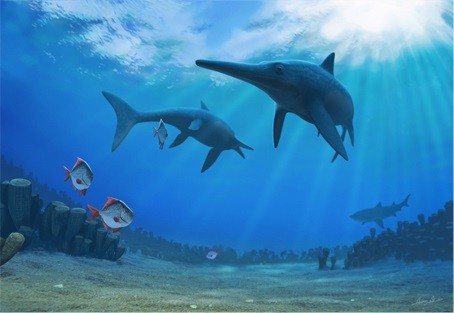By Ana Verayo, | March 09, 2016

Ichthysaurs once ruled the world's oceans but were wiped out due to climate change.
Scientists are still baffled as to how a thriving group of ancient reptilian dolphins known as ichthysaurs that ruled the seas for 150 million years, suddenly disappeared from the face of the Earth.
In this new study, new findings now shed light about the extinction of these prehistoric dolphins some 94 million years ago, which reveals how global warming and their inability to adapt and evolve to this changing climate led to their extinction.
Like Us on Facebook
This new research is also considered to be the most comprehensive and intensive analyses ever to be carried out that challenge initial theories of how the decline of the ichthysaurs for tens of millions of years were caused by new, bigger and more ravenous predators such as giant lizards that swim the oceans called mosasaurs.
Apparently, this new study debunks that theory, as large mosasaurs only appeared in the oceans when the ichthysaurs died out. According to paleontologist Valentin Fischer of the University of Liege in Belgium, the ichthysaurs finally branched out and diversified during the last years of their existence as several species that included different body shapes and sized that are dwelling in different marine habitats, all existed during their evolution, but suddenly became stagnant.
According to paleontologist Roger Benson from the University of Oxford, this extinction was abrupt and not gradual when this massive die off occurred.
These majestic creatures ruled the world some 248 million years ago where they became a crucial part of marine ecosystems during that time. The ichthysaurs possess streamlined bodies that are shaped like modern dolphins' as they are also fast and powerful swimmers with strong flippers and tail flukes similar to sharks. They also had unusually large eyes that can help them hunt prey like fish and squid better in deeper waters, as they give birth to their offspring than laying eggs.
These dolphin-like dinosaurs measured less than three feet long where other species such as the Shonisaurus reached an incredible 70 feet long, some 210 million years ago. Benson says that the Shonisaurus could be the largest animal that appeared on Earth during that time.
When the researchers carefully examined the fossil records of the ichthyosaur, they reconstructed how these creatures evolved and diversified in the process, as they investigated evidence that led to climate change events that coincided with their demise.
During that time, the planet was warming at an unprecedented rate, which would make it the hottest period in the last 250 million years. This climate change event triggered massive fluctuations in sea levels and temperatures where the seafloor decreased in oxygen significantly, making it impossible for marine animals to survive.
These important yet devastating changes then dramatically shifted the migration routes of the ichthysaurs, that also changed the availability of food sources and breeding and birthing places, according to Fischer.
This new study is published in the journal Nature Communications.
-
Use of Coronavirus Pandemic Drones Raises Privacy Concerns: Drones Spread Fear, Local Officials Say

-
Coronavirus Hampers The Delivery Of Lockheed Martin F-35 Stealth Fighters For 2020

-
Instagram Speeds Up Plans to Add Account Memorialization Feature Due to COVID-19 Deaths

-
NASA: Perseverance Plans to Bring 'Mars Rock' to Earth in 2031

-
600 Dead And 3,000 In The Hospital as Iranians Believed Drinking High-Concentrations of Alcohol Can Cure The Coronavirus

-
600 Dead And 3,000 In The Hospital as Iranians Believed Drinking High-Concentrations of Alcohol Can Cure The Coronavirus

-
COVID-19: Doctors, Nurses Use Virtual Reality to Learn New Skills in Treating Coronavirus Patients







